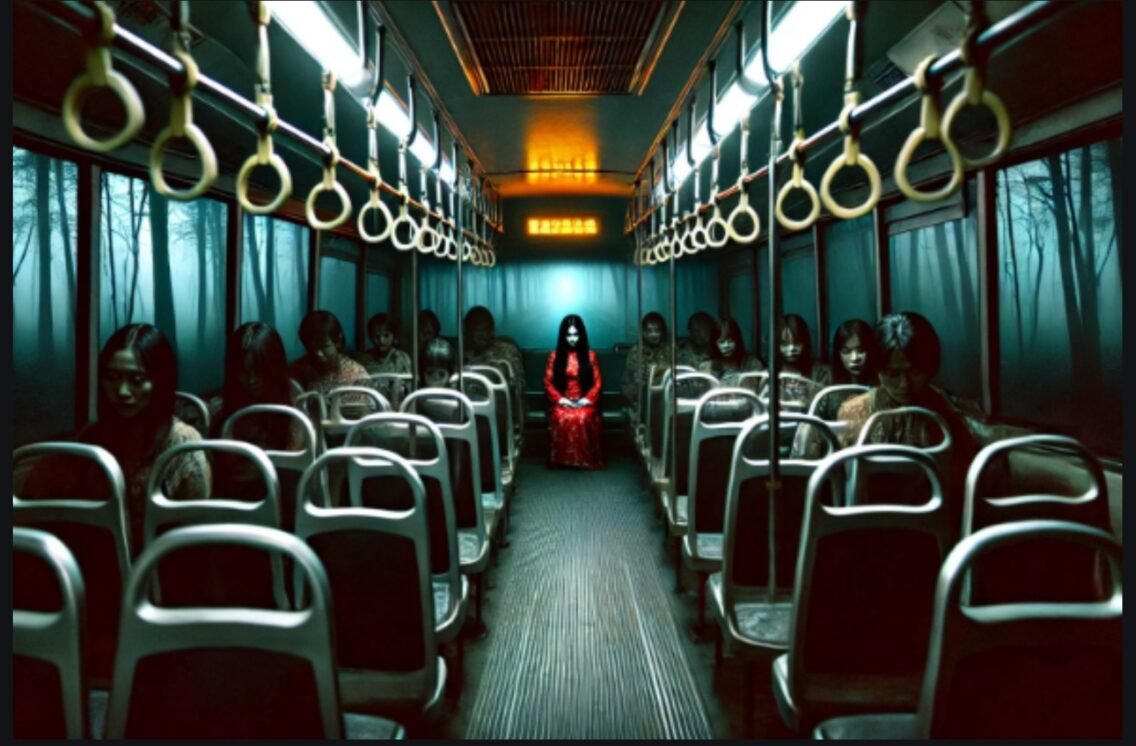The Last Bus to Nowhere

Sarah Lim, 27, Woodlands, Singapore
It was a humid Friday night, and the kind of heat that clings to your skin like a ghostly second layer made the idea of heading home after a long day unbearable. But I had no choice; it was late, and the MRT had already stopped running. My only option was to take the last bus from the interchange, Bus 963, back to Woodlands.
I had heard rumors about late-night buses being… strange. My friends often swapped stories over kopi about phantom passengers or buses taking routes that led nowhere. I always laughed it off as kampong tales—you know, something grandparents tell to scare the young ones.
But that night, as I stepped onto the near-empty bus, a shiver crawled up my spine. It wasn’t the air conditioning; it felt too deliberate, too cold.
The bus driver was an elderly man with a weary face. His eyes barely flicked toward me as I tapped my EZ-Link card. There were only three other passengers: an old lady clutching a bag of oranges, a middle-aged man who looked half-asleep, and a teenage girl staring at her phone.
I took a seat near the back, plugging in my earphones to drown out the hum of the engine. The streets of Bukit Panjang blurred past the window as the bus rolled along, the familiar landmarks slipping into darkness. I tried to focus on my music, but something felt… wrong. The bus moved slower than usual, the kind of slow that makes you uneasy, like it’s being dragged through molasses.
By the time we reached the next stop, the old lady got off. The doors closed with a mechanical hiss, but for a moment, I could’ve sworn I saw something. A shadow darting behind the bus, something too fast to be human. My chest tightened, and I told myself it was just my tired eyes playing tricks.
The bus continued its route, stopping occasionally, but no one else boarded. One by one, the passengers disembarked, leaving only me. It wasn’t until the teenage girl alighted at a dimly lit stop that I realized the middle-aged man was already gone. But I didn’t remember him leaving.
The silence was suffocating. I glanced up at the CCTV camera, seeking some form of reassurance, but the red recording light wasn’t blinking. The camera was off.
I was alone. Or so I thought.
As we approached a stretch of road lined with thick trees, I noticed something unusual. The streetlights were flickering, their orange glow casting eerie shadows. I tapped the bell, hoping to get off early and call a Grab. But the driver didn’t stop.
“Uncle,” I called out, my voice trembling slightly. “I want to get off here.”
He didn’t respond. His gaze was fixed on the road ahead, his hands gripping the steering wheel tightly.
“Uncle!” I shouted louder this time, standing up to walk closer to him. The moment I reached the front, he turned his head slowly, too slowly, and looked at me.
His eyes weren’t normal. They were sunken, hollow, like two pits of darkness. And when he smiled, it wasn’t human. His teeth were jagged, yellow, and far too many to fit in his mouth.
“You can’t get off now, girl,” he said, his voice a low growl that sent chills down my spine. “We’re almost there.”
I stumbled back, clutching the nearest pole for support. The bus picked up speed, the engine growling like a beast as it tore down the road. Outside, the trees seemed to close in, their branches scratching against the windows like skeletal fingers.
I fumbled for my phone, desperate to call someone, anyone. But the screen refused to light up. No signal. Not even the clock displayed. It was as if time itself had stopped.
And then I heard it—a whisper. Faint at first, like the rustling of leaves, but growing louder. It came from the back of the bus.
Turning slowly, I saw her. A woman dressed in a red cheongsam, her face hidden by long black hair. She sat in the last row, her head tilted unnaturally to one side. I hadn’t seen her board. I hadn’t even heard her move. She was just… there.
“Why are you here?” she whispered, her voice like the hiss of escaping steam.
My legs refused to move, my body frozen in fear. She lifted her head, and her face—oh God, her face. It was pale, almost translucent, her eyes sunken and lips cracked. But it was her smile that terrified me the most—wide and jagged, stretching unnaturally across her face.
“You shouldn’t be here,” she repeated, her voice echoing unnaturally.
The bus jolted, throwing me into a seat. When I looked up, she was gone. But the whispering continued, now coming from all around me. Shadows danced along the walls of the bus, figures that shouldn’t be there. They moved erratically, their forms shifting and blending into one another.
“Let me off!” I screamed, banging on the windows, but the glass felt unyielding, as if it had turned to stone.
The driver’s laugh echoed through the bus, a guttural sound that made my skin crawl.
“You wanted to go home, didn’t you?” he mocked, his voice no longer human. “This is home.”
The bus slowed to a stop in the middle of nowhere. Outside, there was nothing but darkness, an endless void that seemed to pulse and breathe. The doors hissed open, and the driver turned to me, his face now completely distorted, his features melting like wax.
“Get off,” he commanded.
I shook my head, tears streaming down my face.
“Get. Off,” he repeated, his voice deep and resonant, shaking the very air around me.
Unable to resist, I stumbled toward the exit. As my foot touched the ground, the darkness enveloped me, cold and suffocating. I couldn’t see, couldn’t breathe. And then, I heard it—a cacophony of voices, screaming, laughing, crying. They were all around me, pulling me deeper into the void.
When I woke up, I was lying on the floor of the bus interchange. The first rays of dawn were breaking through the sky, and commuters bustled around me, oblivious to my presence. My phone buzzed in my pocket, the screen displaying dozens of missed calls from my family.
Analysis of “The Last Bus to Nowhere”
Narrative Strengths
- Relatable Setting:
- The story is grounded in an everyday experience—taking the last bus home late at night. This mundane setting immediately connects with local readers, as public transport is a universal part of life in Singapore.
- The mention of specific details like Bukit Panjang, EZ-Link cards, and kopi sessions adds cultural authenticity and relatability.
- Pacing and Atmosphere:
- The narrative builds suspense gradually. The transition from ordinary to extraordinary is seamless, with small unsettling details (e.g., the bus driver’s behavior, the flickering streetlights) escalating the tension.
- The pacing allows the reader to become immersed in the growing dread, culminating in the terrifying climax.
- Cultural and Supernatural Elements:
- The red cheongsam woman and the eerie bus driver draw upon familiar Southeast Asian horror tropes (e.g., pontianak-like figures and phantom vehicles). These elements resonate with local folklore while still feeling fresh.
- The juxtaposition of traditional ghostly figures with modern-day settings (a bus, phone) bridges old and new horror traditions.
- Psychological Horror:
- The protagonist’s fear is palpable, and the descriptions of her helplessness amplify the psychological tension. Readers are drawn into her perspective, feeling her dread and disorientation.
Areas for Improvement
- Character Development:
- Sarah Lim is relatable, but her backstory could be more fleshed out. Adding details about her personal life or why she’s on the last bus (e.g., a stressful job, a recent loss) would deepen emotional engagement.
- More Local References:
- The setting could include additional iconic landmarks or subtle nods to Singapore’s unique culture, further anchoring the story in its local context.
- Ending Ambiguity:
- While the ending is effective, it might benefit from more clarity about Sarah’s fate. Is the experience purely supernatural, or is there a psychological element (e.g., sleep paralysis, trauma)?
Horror Themes Explored
- Fear of the Familiar Turning Strange:
- The bus, a safe and predictable environment, becomes a vessel of terror. This inversion of the familiar is a classic horror technique.
- Urban Isolation:
- Despite being in a crowded city, Sarah’s isolation highlights how urban life can feel lonely and vulnerable, especially at night.
- Supernatural Consequences:
- The story hints at rules and boundaries (e.g., don’t take the last bus or break unseen taboos), tapping into the idea of karmic retribution or fate.





